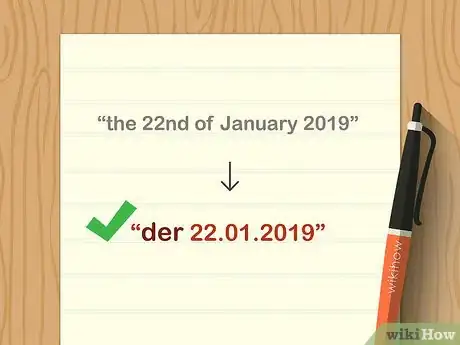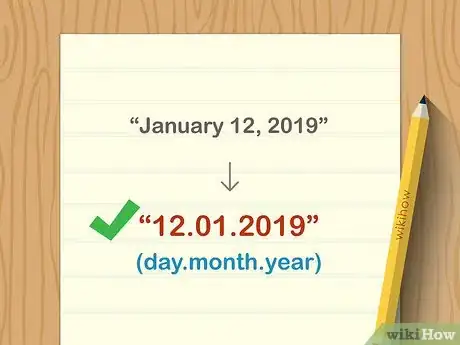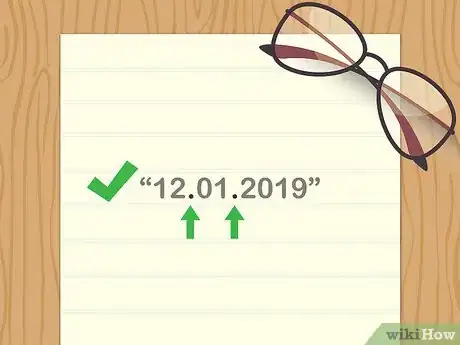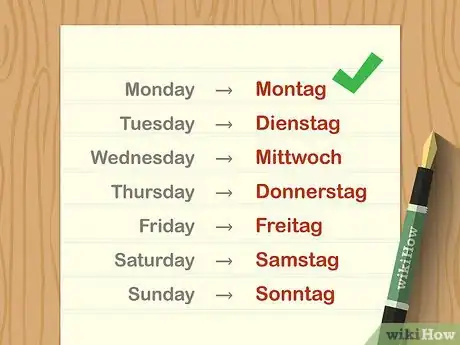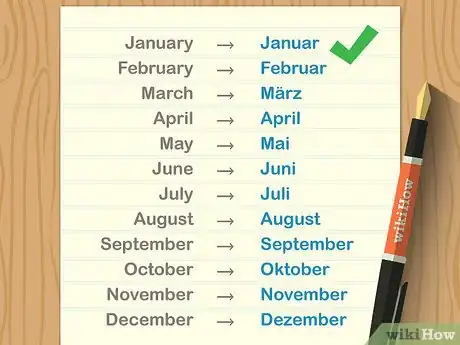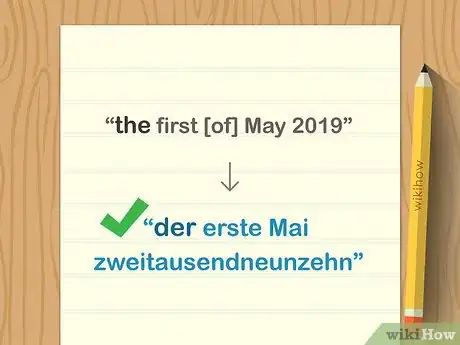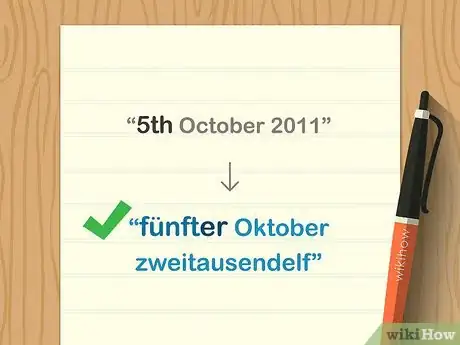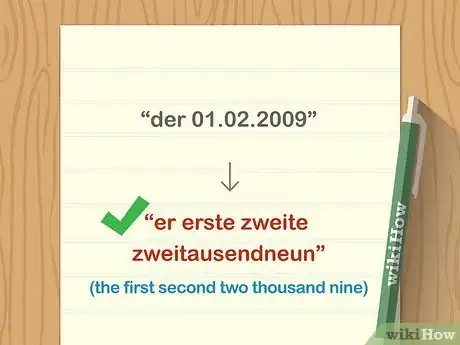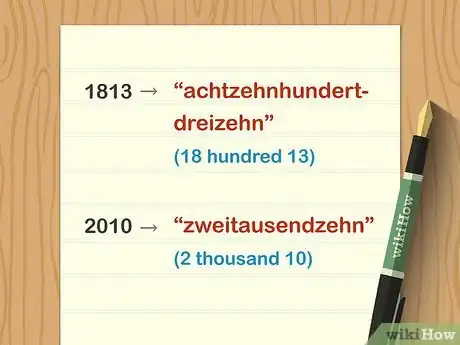This article was co-authored by wikiHow staff writer, Jennifer Mueller, JD. Jennifer Mueller is a wikiHow Content Creator. She specializes in reviewing, fact-checking, and evaluating wikiHow's content to ensure thoroughness and accuracy. Jennifer holds a JD from Indiana University Maurer School of Law in 2006.
This article has been viewed 92,933 times.
Learn more...
Whether you're writing a letter to a German friend or booking travel accommodations for a trip to Munich, knowing how to write the date (das Datum) in German will help you avoid miscommunication. In German, whether writing the date using only numbers or using a combination of words and numbers, you list the day first, followed by the month, then the year. In many situations, the date is also preceded by an article or a preposition.[1]
Steps
Using Only Numbers
-
1Include an article before the date. In some situations, such as in letters or other formal writing, the date is preceded by the article der, which means "the," or am, meaning "on" or "on the."[2]
- For example, if you wanted to talk about an event that happened on January 22, 2019, you would write der 22.01.2019 to mean "the 22nd of January 2019," or am 22.01.2019 to mean "on the 22 of January 2019."
-
2Write the date in day-month-year format. When writing a date in German, list the day of the month first, followed by the numeral for the month, followed by the year. Germany uses the Gregorian calendar, with 12 months from January through December.[3]
- For example, if you saw 01.04.2019 in German, this date is April 1st, 2019 – not January 4th.
Tip: When dealing with a single-digit day or month, put a "0" before the digit to act as a placeholder. For example, for July 4th, 2019, you would write der 04.07.2019.
Advertisement -
3Separate the parts of the date with periods. Use a period or full-stop after the numeral representing the day and the month. Do not include a space after the period. There's no need for a period after the year unless the date happens to fall at the end of a sentence.[4]
- For example, if you wanted to write the date January 12, 2019 numerically in German, you would write "12.01.2019".
Including Words and Numbers
-
1List the day of the week first if necessary. In some situations, you may need (or simply want) to include the name of the day of the week when writing out a date. Usually, you would do this on an invitation to an event or a notification of a meeting. The name of the day of the week is followed by a comma.[5]
- For example, you might write "Dienstag, 22. Januar 2019." (Tuesday, 22nd January 2019).
- In German, the days of the week are Montag (Monday), Dienstag (Tuesday), Mittwoch (Wednesday), Donnerstag (Thursday), Freitag (Friday), Samstag (Saturday), and Sonntag (Sunday).[6]
Tip: In German, the days of the week are capitalized just as they are in English. Monday is the first day of the week and Sunday is the seventh or last day of the week.
-
2Write the number of the day followed by a period. The period (or full-stop) after the numeral indicating the day of the month signals that the number is an ordinal. Unlike when writing the date using only numbers, there is a space after the period and before the name of the month.[7]
- For example, you would write "July 4, 2019" as der 4. Juli 2019.
Tip: When using both words and numbers to write the date, you don't need to include a "0" as a placeholder for single-digit days.
-
3Add the name of the month and the numerals for the year. After the day of the year, write out the name of the month. Type a space, then close your date with the numerals of the year. There's no punctuation between the month and the year.[8]
- For example, you would write "December 24, 2019" as der 24 Dezember 2019.
- The months of the year in German are: Januar (January), Februar (February), März (March), April (April), Mai (May), Juni (June), Juli (July), August (August), September (September), Oktober (October), November (November), and Dezember (December). They're fairly easy to recognize and remember if you already know the months of the year in English.
Saying the Date Aloud
-
1Start with an article or a preposition if appropriate. When you write or say the date in German, you typically precede the actual date with der (meaning "the") or am (meaning "on").[9]
- For example, you would say der erste Mai zweitausendneunzehn for "the first [of] May 2019."
-
2Read the number of the day as an ordinal. The period after the numeral indicates this number is an ordinal. The ending of the ordinal changes if you say the date along with a preposition, such as am, or an article, such as der.[10]
- If there is no article or preposition, the ordinal ends in -er. For example, you would say fünfter Oktober zweitausendelf to mean "5th October 2011." If you happen to use an indefinite article, such as ein (meaning "a" or "an"), you would also end the ordinal with -er.
- When using a definite article, such as der, the ordinal ends in -e. For example, you would say der fünfte Oktober zweitausendelf to mean "the 5th [of] Oktober 2011."
- If a preposition precedes the date, the ordinal ends in -en. For example, you would say am fünften Oktober zweitausendelf to mean "on [the] 5th [of] Oktober 2011."
-
3Use an ordinal to read the number of the month. If the name of the month is written out, you would just say the name of the month. However, if you're reading a date in German that's written using only numbers, you read the month as an ordinal number rather than saying the name of that month.[11]
- For example, if you saw der 01.02.2009, you would read it as der erste zweite zweitausendneun, or "the first second two thousand nine."
-
4Read years prior to 1999 as hundreds and later years as cardinal numbers. The way you say the numbers for the years in German changed beginning in the year 2000. Prior to that year, numbers are read as hundreds. For the year 2000 and beyond, read the number as it appears.[12]
- For example, you would read the year 1813 as achtzehnhundertdreizehn, meaning "18 hundred 13." However, the year 2010 is read zweitausendzehn, or "2 thousand 10."
Tip: Don't add the word und or "and" when reading the year, unless it's part of the number. So 1995 would be neunzehnhundertfünfundneunzig, or "19 hundred 5 and 90," but 1617 would be sechzehnhundertsiebzehn, or "16 hundred 17," not "16 hundred and 17."
References
- ↑ https://deutsch.lingolia.com/en/vocabulary/numbers-dates-time/date
- ↑ https://www.germanveryeasy.com/date
- ↑ https://deutsch.lingolia.com/en/vocabulary/numbers-dates-time/date
- ↑ https://langster.org/en/blog/how-to-read-and-write-dates-in-german-with-audio
- ↑ https://deutsch.lingolia.com/en/vocabulary/numbers-dates-time/date
- ↑ https://www.germanveryeasy.com/date
- ↑ https://www.germanveryeasy.com/date
- ↑ https://www.germanveryeasy.com/date
- ↑ https://deutsch.lingolia.com/en/vocabulary/numbers-dates-time/date
